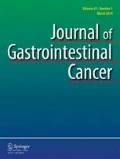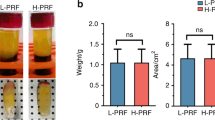Summary
Objectives. Poor prognosis after resection of primary colorectal cancer may be related to the combination of perioperative blood transfusion and subsequent development of infectious complications. Various white cell- and platelet-derived cancer-growth substances may be involved in this process. Therefore, we studied the in vitro release of substances from white cells and platelets stimulated by bacterial antigens and supernatants from stored red-cell components.
Methods. Eight units of whole blood (WB) and 8 U of buffy-coat-depleted red-cell (SAGM) blood were donated by healthy blood donors. Subsequently, one-half of each unit was leucocyte-depleted by filtration, and all 32 half-units were stored under standard conditions for 35 d. Just after storage, and on d 7, 21, and 35 during storage, aliquots of the supernatants were removed from the units and frozen at −80°C. WB from other healthy donors was stimulated for 2 h with sodium chloride (controls), with Escherichia coli (E. coli) lipopolysaccharide (LPS) alone, or with LPS plus supernatants from the WB units (diluted 1:10), or from the SAGM units (diluted 1:20) stored for 0, 7, 21, or 35 d, respectively. Similar assays were performed using Staphylococcus aureus-derived protein A as a stimulatory antigen. The concentration of eosinophil cationic protein (ECP), myeloperoxidase (MPO), histamine (HIS), and plasminogen-activator inhibitor-1 (PAI-1) were determined in supernatants from the stored blood and in assay supernatants by using enzyme-linked immunosorbent assay (ELISA) and radioimmunoassay (RIA) methods.
Results. The extracellular concentration of ECP, MPO, and HIS increased significantly in a storage-time-dependent manner in nonfiltered WB and SAGM blood, and the increase was abrogated by prestorage leukofiltration. Similarly, PAI-1 increased significantly in nonfiltered WB, and the increase was abrogated by prestorage leukofiltration. The supernatant concentrations of the four substances were significantly increased in LPS-stimulated (0.5-4 fold) and in protein A-stimulated (0.5-13.5-fold) assays compared with controls. The addition of supernatants from stored nonfiltered WB or SAGM blood significantly increased the assay supernatant of ECP, MPO, HIS, and PAI-1 concentrations storage--time-dependently in LPS-stimulated assays. Prestorage leukofiltration abrogated the additional effect of supernatants from stored blood. Similar results were observed for ECP and HIS through the addition of supernatants from stored blood to protein A-stimulated assays. Protein A stimulation did not lead to increased PAI-1 release in assays diluted by supernatants from stored blood. However, the MPO concentrations were significantly (p=0.004), and independent of storage time and leukofiltration, increased in protein A-stimulated assays diluted by supernatants from stored blood compared with sodium chloride dilution.
Conclusion. Extracellular ECP, MPO, HIS, and PAI-1 accumulate during storage of nonfiltered red-cell components, but the accumulation can be prevented by prestorage leukofiltration. In addition, bacterial antigens appear to induce significant release of the substances from white cells and platelets. Addition of supernatants from stored, nonfiltered WB and SAGM blood may increase the substance levels in a storage-time-dependent manner, and prestorage leukofiltration may prevent further increase by supernatants, except for MPO.
Similar content being viewed by others
References
Blumberg N. Allogeneic transfusion and infection: economic and clinical implications. Semin Hematol 1997;24:34–40.
Nielsen HJ. Clinical impact of bioactive substances in blood components: Implications for leukocyte filtration. Infus Ther Transfus Med 1998;25:296–304.
Vamvakas EC, Blajchman MA. Deleterious clinical effects of transfusion-associated immunomodulation: fact or fiction? Blood 2001;97:1180–1195.
Edna TH, Bjerkeset T. Association between transfusion of stored blood and infective bacterial complications after resection for colorectal cancer. Eur J Surg 1998;164:449–456.
Chang H, Hall GA, Geerts WH, et al. Allogeneic red blood cell transfusion is an independent risk factor for the development of postoperative bacterial infection. Vax Sang 2000;78:13–18.
Mynster T, Nielsen HJ. The impact of storage time of transfused blood on postoperative infectious complications in rectal cancer surgery. Scand J Gastroenterol 2000;35:212–219.
Grandis JR, Snyderman CH, Johnson JT, et al. Postoperative wound infection. A poor prognostic sign for patients with head and neck cancer. Cancer 1992;70:69–73.
Swisher SG, Holmes EC, Hunt KK, et al. Perioperative blood transfusions and decreased long-term survival in oesophageal cancer. J Thorac Cardiovasc Surg 1996;112:341–348.
Mynster T, Christensen IJ, Moesgaard F, et al. Effects of the combination of blood transfusion and postoperative infectious complications on prognosis after colorectal cancer surgery. Br J Surg 2000;87:1553–1562.
Blumberg N, Heal JM. Immunomodulation by blood transfusion: an evolving scientific and clinical challenge. Am J Med 1996;101:299–308.
Blajchman MA, Dzik S, Vamvakas EC, et al. Clinical and molecular basis of transfusion-induced immunomodulation: summary of the proceedings of a state-of-the-art conference. Transfus Med Rev 2001;15:108–135.
Nielsen HJ, Edvardsen L, Vangsgaard K, et al. Time-dependent histamine release from stored human blood products. Br J Surg 1996;83:257–262.
Nielsen HJ, Reimert CM, Pedersen AN, et al. Time-dependent, spontaneous release of white cell- and platelet-derived bioactive substances from stored human blood. Transfusion 1996;36:960–965.
Nielsen HJ, Werther K, Mysnter T, et al. Soluble vascular endothelial growth factor in various blood transfusion components. Transfusion 1999;39:1078–1083.
Mynster T, Dybkjaer E, Kronborg G, et al. Immunomodulation by blood transfusion: is storage time important? Vox Sang 1998;74:176–181.
Vamvakas EC, Carven JH. Transfusion and postoperative pneumonia in coronary artery bypass graft surgery: effect of the length of storage of transfused red cells. Transfusion 1999;39:701–710.
Zallen G, Offner PJ, Moore EE, et al. Age of transfused blood is an independent risk factor for postinjury multiple organ failure. Am J Surg 1999;178:570–572.
Nielsen HJ, Werther K, Mynster T, et al. Bacteria-induced release of white cell- and platelet-derived vascular endothelial growth factor in vitro. Vox Sang 2001;80:170–178.
Mynster T, Hammer JH, Nielsen HJ. Prestorage and bedside leukofiltration of whole blood modulates storage time-dependent suppression of in vitro TNFα release. Br J Haematol 1999;106:248–251.
Effersoe H, Espersen F, Andersen V. Induction of immunoglobulin secretion in cultured human lymphocytes by 4 Staphylococcus aureus strains and their extracts. APMIS 1984;92:121–128.
Nielsen HJ, Rosendahl S, Sigvard S, et al. Storage time-dependent changes in the relative white cell-derived substance content in buffy-coat-depleted SAGM blood. Transfusion 2000;40:69S-70S.
Reimert CM, Venge P, Kharazmi A, et al. Detection of eosinophil cationic protein (ECP) by an enzyme-linked immunosorbent assay. J Immunol Methods 1991;138:285–290.
Fredens K, Dybdahl H, Dahl R, et al. Extracellular deposit of the cationic proteins ECP and EPX in tissue infiltrations of eosinophils related to tissue damage. APMIS 1988;96:711–719.
Kaufman LE. The expanding clinical spectrum of multisystem disease associated with eosinophilia. Arch Dermatol 1997;133:225–227.
Kurose I, Granger DN. Evidence implicating xanthine oxidase and neutrophils in reperfusion-induced microvascular dysfunction. Ann NY Acad Sci 1994;723:158–179.
Borregaard N, Cowland JB. Granules of the human neutrophilic polymorphonuclear leukocyte. Blood 1997;89:3503–3521.
Cerutti PA. Oxy-radicals and cancer. Lancet 1994;344:862–863.
Qureshi A, Gorey TF, Byrne P, et al. Oxygen free radical activity in experimental colonic carcinoma. Br J Surg 1994;81:1058–1059.
Nielsen HJ. The effect of histamine type-2 receptor antagonists on posttraumatic immune competence. Dan Med Bull 1995;42:162–174.
Watson SA, Wilkinson LJ, Robertson JRF, et al. Effect of histamine on growth of human gastrointestinal tumours: reversal by cimetidine. Gut 1993;34:1091–1096.
Adams WJ, Lawson JA, Morris DL. Cimetidine inhibits in vivo growth of human colon cancer and reverses histamine stimulated in vitro and in vivo growth. Gut 1994;35:1632–1636.
Van Goor H, de Graaf JS, Grond J, et al. Fibrinolytic activity in the abdominal cavity of rats with faecal peritonitis. Br J Surg 1994;81:1046–1049.
Juhan-Vague I, Alessi MC, Morange PE. Hypofibrinolysis and increased PAI-1 are linked to atherothrombosis via insulin resistance and obesity. Ann Med 2000;32:78–84.
Pappot H, Gardsvoll H, Romer J, et al. Plasminogen activator inhibitor type 1 in cancer: therapeutic and prognostic implications. Biol Chem Hoppe Seyler 1995;376:259–267.
Bajou K, Noel A, Gerard RD, et al. Absence of host plasminogen activator inhibitor 1 prevents cancer invasion and vascularization. Nat Med 1998;4:923–928.
Mynster T, Nielsen HJ. Storage tiem of transfused blood and disease recurrence after colorectal cancer surgery. Dis Colon Rectum 2001;44:955–964.
Pedersen AN, Brunner N, Hoeyer-Hansen G, et al. Determination of the complex between urokinase and its type-1 inhibitor in plasma from healthy donors and breast cancer patients. Clin Chemistry 1999;45:1206–1213.
Nordenbaek C, Johansen JS, Junker P, et al. YKL-40, a matrix protein of specific granules in neutrophils, is elevated in serum of patients with community-acquired pneumonia requiring hospitalisation. J Infect Dis 1999;180:1722–1726.
Ratjen F, Havers W, Braun J. Intrapulmonary protein leakage in immunocompromised children and adults with pneumonia. Thorax 1999;54:432–436.
Author information
Authors and Affiliations
Corresponding author
Rights and permissions
About this article
Cite this article
Hammer, J.H., Mynster, T., Rosendahl, S. et al. Bacterial antigen-induced release of white cell- and platelet-derived bioactive substances in vitro. Int J Gastrointest Canc 31, 165–179 (2002). https://doi.org/10.1385/IJGC:31:1-3:165
Issue Date:
DOI: https://doi.org/10.1385/IJGC:31:1-3:165




